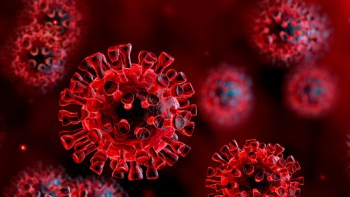
Emperor penguins huddle together for warmth when weather conditions deteriorate below a critical “apparent temperature” in a process that resembles a physical phase transition. That is the conclusion of an international team of scientists who have studied the penguins in Antarctica and developed a mathematical model of their behaviour. Their research could lead to a new way of measuring the health of emperor penguin colonies and how they adapt to a changing climate.
Emperor penguins breed during the frigid Antarctic winter. Once they have mated and the females have set off to forage, the males are left to incubate the eggs. A bird will rest its egg on its feet and cover it with a fold of skin to maintain its offspring at a balmy 38° C.
The males must endure temperatures below -50° C, wind speeds in excess of 150 km/h and starvation for as long as 130 days until the females return. As a result, they need to conserve as much energy as possible if they and their chicks are to survive.
Penguin teamwork
The males keep warm by working as a team. Waddling into a densely packed huddle, the colony shares body heat and individuals shelter each other from the biting conditions. This works so well that temperatures deep inside a huddle can reach as high as 37.5° C.
But exactly what weather conditions must be present to drive the penguins into a huddle remained a mystery until it was investigated by Sebastian Richter and colleagues at the University of Erlangen-Nuremberg, the Scientific Centre of Monaco, the University of Strasbourg and the Woods Hole Oceanographic Institution.
We did not have a concept of what ‘feeling cold’ actually means for an emperor penguin
Sebastian Richter, University of Erlangen-Nuremberg
“It is an intuitive thought that the colder a penguin feels the more likely it is to look for the proximity of others to share body heat and shelter from the wind,” says Richter. “But we did not have a concept of what ‘feeling cold’ actually means for an emperor penguin.”
Time-lapse photographs
To study the huddling behaviour, the physicists set up a camera to take time-lapse photographs of an emperor penguin colony less than a kilometre from the French Antarctic research station Dumont d’Urville. They chose a period between mid-April and the end of May to take the pictures in order to ensure no chicks were present that could influence the colony’s behaviour, and used the facilities at Dumont d’Urville to record meteorological data.
The team draws an analogy between the huddling transition and the phase change that occurs when a liquid or gas becomes a solid. In their model, the area occupied by the penguins indicates the phase of the colony. A tight huddle occupying a small area signifies a solid state and less dense clusters are described as liquid or gas phases. A similar analogy was used in previous work by team members that analysed the distribution of sites occupied by breeding pairs of king penguins.
Richter and colleagues then defined a phase transition point to be the “apparent temperature” at which half of the penguins are in a huddle. The apparent temperature is a combination of temperature, wind speed, sunlight and humidity. Applying a Bayesian sampling process, the researchers used weather observations from Dumont d’Urville to quantify the contribution of each of the meteorological factors to the apparent temperature.
Adaptive advantage
The mathematical biologist Mauricio Canals Lambarri of the University of Chile is enthusiastic about the results. “I think it is a remarkable example of an environmentally triggered process of self-organization that extends to a group,” he says. “And this group acquires an adaptive advantage that ultimately results in a better biological fitness of the species.” However, he also says the work would benefit from studying a larger number of specimens and more species, which would allow the researchers to generalize the conclusions.

Why penguin colonies look like liquids
Richter and colleagues are now focusing on expanding their model with more data over a larger time interval and across different colonies and locations. He believes the team’s relatively simple and affordable method could in future be applied to measure how different colonies cope with a changing climate.
“A shift in the phase transition temperature, i.e. the temperature at which penguins begin to feel cold and start huddling, could provide valuable information on the energy budget of a colony,” he says. “A higher transition temperature could indicate a lower cold tolerance – hence lower insulation and less energy reserves – serving as an integrated indicator of the pre-breeding foraging success at sea and the strain experienced on land during the breeding period.”
The research is described in Journal of Physics D: Applied Physics.



